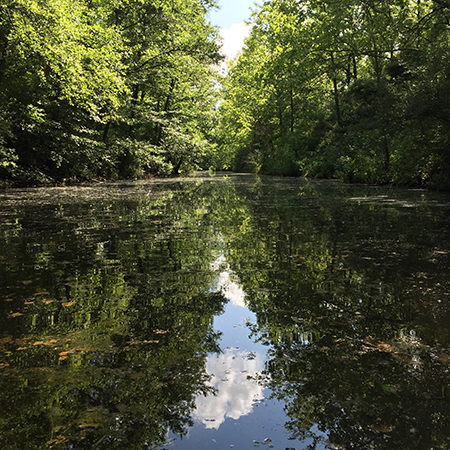On warm afternoons, one of my favorite things to do is slip my kayak into the still waters at Finger Lakes State Park in Boone County. Dragonflies dance and dive across the surface as I glide past the tree-lined banks. As my husband and I navigate our kayaks through the tranquil 4.5-mile water trail in the park, occasionally, we’ll surprise a great blue heron looking for a meal. Certainly, white-water rivers are an option, but for us, a lazy afternoon on a lake is perfect. He fishes and I float; destressing on the water is great therapy.
Bringing my cell phone on these voyages is about as unplugged as I get. Although a clear picture of fleeing heron is elusive, the phone is useful as a camera. My photos document the beauty of my surroundings, but they don’t quite capture the peace the park brings me. Still, I share them on Instagram for posterity, as if to ask, “Don’t you want to be here?”
A former coal strip mine, Finger Lakes is one of 87 state parks and historic sites statewide, each with their own beauty. That beauty is the result of meticulous care of our state’s resources. The old adage, “nothing is ever free,” holds true. More than 30 years ago, Missourians recognized the necessity and made the conscious choice to preserve and protect our water, soil and state parks through the passage of a one-tenth-cent sales tax to fund programs for that purpose.
A sunset tax, the parks, soils and water sales tax comes before voters every 10 years for renewal. It will be on the ballot later this year. Since 1984, this sales tax has provided funds to improve our footprint on our natural resources. Soil and water programs have helped Missouri landowners keep more than 177 million tons of soil from eroding into Missouri waterways. Erosion rates have decreased by half since the sales tax’s original passage.
Funds have also helped maintain and improve our state park system, often cited as one of the best in the country. Missouri’s state parks and historic sites host more than 18 million visitors annually and have an economic impact of more than $1 billion. I am one of those millions and a small part of those billions.
It’s safe to say all Missourians want clean water, healthy soil and parks to enjoy, and as we have learned from experience, those things take the work and dedication of many organizations and people. It’s an ongoing process. Just like keeping a house clean, our environment needs management and funds to make that quality care possible, which by extension improves our quality of life.
The question will be: Are Missouri’s water, soil and parks as important to citizens today as they were in 1984? Well, they are to me and my kayak.


